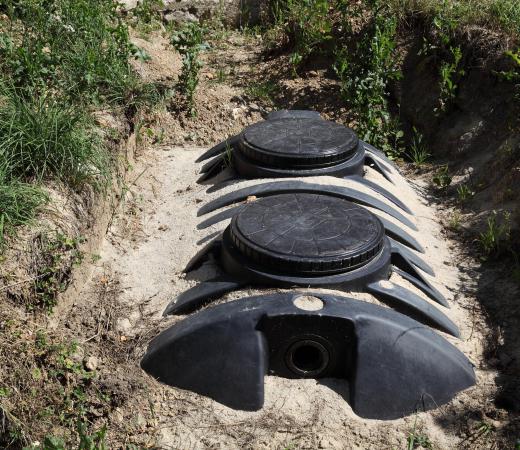A septic tank diagram can refer to one of two things. The first is a detailed drawing or set of plans showing the various parts of the septic system. This may be used in building or installing the septic tank, as well as in providing plumbers and other professionals a detailed map for doing repairs. The second type is a map or sketch showing exactly where on a property to find certain aspects of the tank.
Most septic systems are composed of many parts or sections. Each of these sections fulfills a particular purpose. The tank itself is generally a large tank made from concrete or steel that is buried in the yard of a house. Waste and water flow into one end of the tank where it naturally separates into different parts or layers. There is also an abundance of certain bacteria to help break down solid waste.

As the tank becomes full, water flows out the other end and flows into the drain field. The drain field is a large system of perforated pipes. Water slowly seeps from the pipes and into the ground, where it is filtered by the surrounding earth. If the drain field has a leak or collapsed pipe, this is usually a telltale sign of a septic system that is too full.
The septic tank diagram helps to give homeowners a better idea of how the septic system actually works. Plans generally include information such as how much water the tank can hold, what the tank is made from, and how far away the drain field is. Keeping a close eye on how the drain field is functioning is important for proper septic tank maintenance.
Having one of each type of septic tank diagram is useful for every homeowner. They can be very useful in hiring others to do repairs, as well as in helping homeowners locate sections of the tank and septic system in order to perform simple maintenance. If a septic tank diagram is not done as the home is being built, or has been lost due to the home being bought and sold by multiple owners, it may be possible to have one drawn by a licensed professional during maintenance or repairs.
When buying a new home, it is recommended that the new owners request to see the septic tank diagram to keep in a safe place. Real estate agents or the previous owners may have this on hand, but if not, a new diagram may be drawn for a fee. A professional plumber or former owners may also be able to tell homeowners where key parts of the system are to make repairs do routine maintenance.
